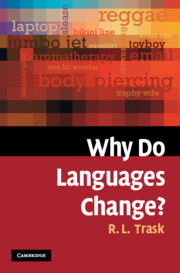Book contents
- Frontmatter
- Contents
- List of figures and tables
- A few words before we start
- Acknowledgements
- 1 How do languages change?
- 2 Why are languages always changing?
- 3 Where do words come from?
- 4 Skunk-Leek – my kind of town: what's in a name?
- 5 Where does English come from?
- 6 Why is American English different from British English?
- 7 Why is English spelling so eccentric?
- 8 Which is the oldest language?
- Some final thoughts
- Further reading
- Index
4 - Skunk-Leek – my kind of town: what's in a name?
Published online by Cambridge University Press: 05 June 2012
- Frontmatter
- Contents
- List of figures and tables
- A few words before we start
- Acknowledgements
- 1 How do languages change?
- 2 Why are languages always changing?
- 3 Where do words come from?
- 4 Skunk-Leek – my kind of town: what's in a name?
- 5 Where does English come from?
- 6 Why is American English different from British English?
- 7 Why is English spelling so eccentric?
- 8 Which is the oldest language?
- Some final thoughts
- Further reading
- Index
Summary
Names are peculiar
Far more than ordinary words, names develop historically in ways which are complicated, unexpected and downright peculiar. Names are subject to all sorts of local and idiosyncratic changes, and we usually cannot predict how one name will behave by watching what happens to another one.
For example, I live in the English city of Brighton. What is the origin of this name? The ending looks familiar enough: there are hundreds of settlement names ending in -ton, which represents the Old English word tūn ‘enclosed piece of land’, ‘homestead’, later ‘village’. But this leaves us apparently stuck with bright, certainly a good English word, but one that would be singular in its construction for all English names from that period. Often we find -ton attached to a personal name, as in Edgbaston, from the Old English personal name Ecgbald, and thus meaning ‘Ecgbald's homestead’, or to the name of a geographical feature, as in the common Stratton, whose first element is Old English strœt ‘Roman road’, so that the whole is ‘village by a Roman road’. The use of an adjective like bright in this context would be otherwise unknown, however.
The study of names depends absolutely upon the scrutiny of documents, and in this case we are lucky enough to have documentation of the history of the name. The earlier form of Brighton, our documents reveal, was Bristelmestun, or Brighthelmston, a perfectly ordinary and transparent name meaning ‘Brighthelm's homestead’.
- Type
- Chapter
- Information
- Why Do Languages Change? , pp. 64 - 83Publisher: Cambridge University PressPrint publication year: 2009



